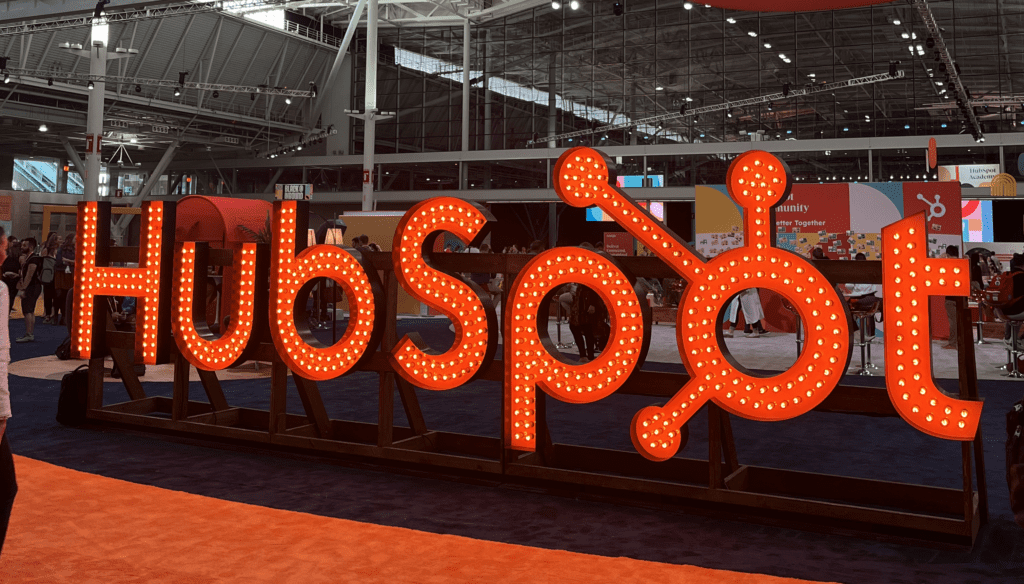Lessons from Inbound: Building Community & Reaching Customers by Caring
At its 2022 Inbound conference, HubSpot announced the launch of HubSpot Connect—so it was only natural that the conference centered around building community. But it’s no marketing scheme. In fact, creating and cultivating a community of B2B marketing, sales, and revenue professionals is exactly how HubSpot has built and grown its market share. Their leaders are simply teaching from experience.

Disconnection in Sales, Marketing, & Revenue Strategies
In her kickoff speech, HubSpot CEO Yamini Rangan spoke about the “Age of the Connected Customer.” Despite humans being more connected than ever, there are still points of disconnect, which we often see with our new and prospective clients.
- Disconnected Tech Stacks (Systems & Data): Sometimes there are too many tools and not enough connection between them. There’s often one tool for CRM, one for marketing, one for sales, and one for analytics, and they don’t speak to each other.
- Disconnected from Co-Workers or Support Systems: We no longer stop by each other’s desks to ask a question or problem-solve a challenge. Our sales teams don’t talk to our marketing teams (and vice versa) to improve the overall revenue system.
- Disconnected from Customers & Clients: Our content creation rates are higher than ever, but we can’t reach prospects or cut through the noise. Digital fatigue and distrust are ever-present.
In short: Your audiences are tired, so you need more connection than just an email or blog post.
How Do We Improve Customer Connection?
We collected advice from the various Spotlight and Breakout Sessions our employees attended at the Inbound conference. The largest themes were:
- Improving Personalization
- Building Trust
- Cultivating Community & Resources
Improving Personalization
Personalization can reduce acquisition costs and increase revenue, making your marketing efforts more efficient. And in many cases, users are actually willing to share information to enable personalization.
But personalization demands good data; if your data is bad, so is your personalization strategy. And disconnected systems = bad data. So, before you tackle these other items, tackle your tech stack! The following best practices are a good start:
- Segment Users and Content: Prioritizing segmentation isn’t new, but it is more important now than ever. With users experiencing so much digital noise, it’s integral that we don’t fatigue them with content that isn’t relevant to their experience. Here’s some sub-segment thought-starters:
- B2B vs. B2C prospects and clientele
- Geography
- Lifecycle stage (users at the awareness stage vs the decision stage should experience very different content topics!)
- Interest categories (based on page clicks or other metrics)
- Personalize Visuals, Too: Use imagery and video to help your audience identify with your content. Imagery for B2C customers could look drastically different from imagery for B2B customers!
- Take a Funnel Approach to Personalization: Users who are experiencing your brand for the first time don’t need the same information as those who are moments away from a decision. Break up your content, email, and website strategy by funnel, and use landing page, ad, and website personalization to customize each experience.
(P.S. If you use HubSpot, you have personalization activities and tools at your fingertips!)
Building Trust
- Improve Your Email Marketing: Customers look to their peers and community for advice on making purchasing decisions. Accordingly, adding reviews and testimonials to emails significantly increases click rates and landing page conversions.
- Don’t Bury the Lede: Even Google algorithms are changing to serve answers faster and more efficiently. Answer user questions quickly and don’t bury the insights beneath a sea of SEO fluff. Meet users with the mediums (video!) they love.
- Give Them the Power: Self-education is huge in B2B. Users want to be able to do their own research and they’ll begin with your resources. Use testimonials, educational content, and videos that get them familiar with your platform or product.
More importantly, let them customize what they don’t want to see. We’re talking topics, categories, and even subscription options. Let them subscribe to the pieces of your marketing they enjoy the most and get the most value from.
- Heed These Personalization Warnings: While personalization is integral to connecting with customers, they only want to see information they’ve chosen to share with you. Don’t creep them out by purchasing or supplementing information and surprising them with it on a page.
- Reduce Friction: Apply this to your sales process, your website journey, and more. If it’s difficult, it’s not happening! Make it easy for customers and prospects to ask questions, request more information, download insights, and purchase.
Cultivating Community
Later at Inbound, HubSpot Co-founder and CTO Dharmesh Shah introduced HubSpot Connect, a new connected community for growth professionals. It was created to build on a solid foundation of reliable software and engaging content and to bridge gaps in solving customer problems. How can you replicate this idea?
- Encourage Customers to Talk to Each Other: Create opportunities for your clients and customers to speak with one another to problem-solve. Make these opportunities easily accessible with forums, chats, user groups, brainstorming groups, and more to facilitate forming a community.
Here’s a great example: One of our SaaS clients recently released community groups and product add-ons that allow their own clients to share information and ideas with each other for an optimal experience.
- Make Sure Your Sales & Marketing Functions are Collaborative: The buying journey is a collaboration between sales and marketing, and your business strategies and processes should reflect that. But collaboration doesn’t always come naturally, so you’ll need to work at it.
As your marketing and sales teams begin to share more information, you’ll see a vast improvement in your revenue funnel. Sales teams can share feedback on lead quality and what prospects are asking, so marketing can improve its processes and generate content ideas that speak to the user. On the flip side, marketing can provide sales with materials or recommendations that improve and supplement the sales process.
Our team learned a lot from Inbound, and we’re already implementing some terrific recommendations internally and on behalf of our clients. We can’t wait to see how it impacts our team’s work and our clients’ results!







